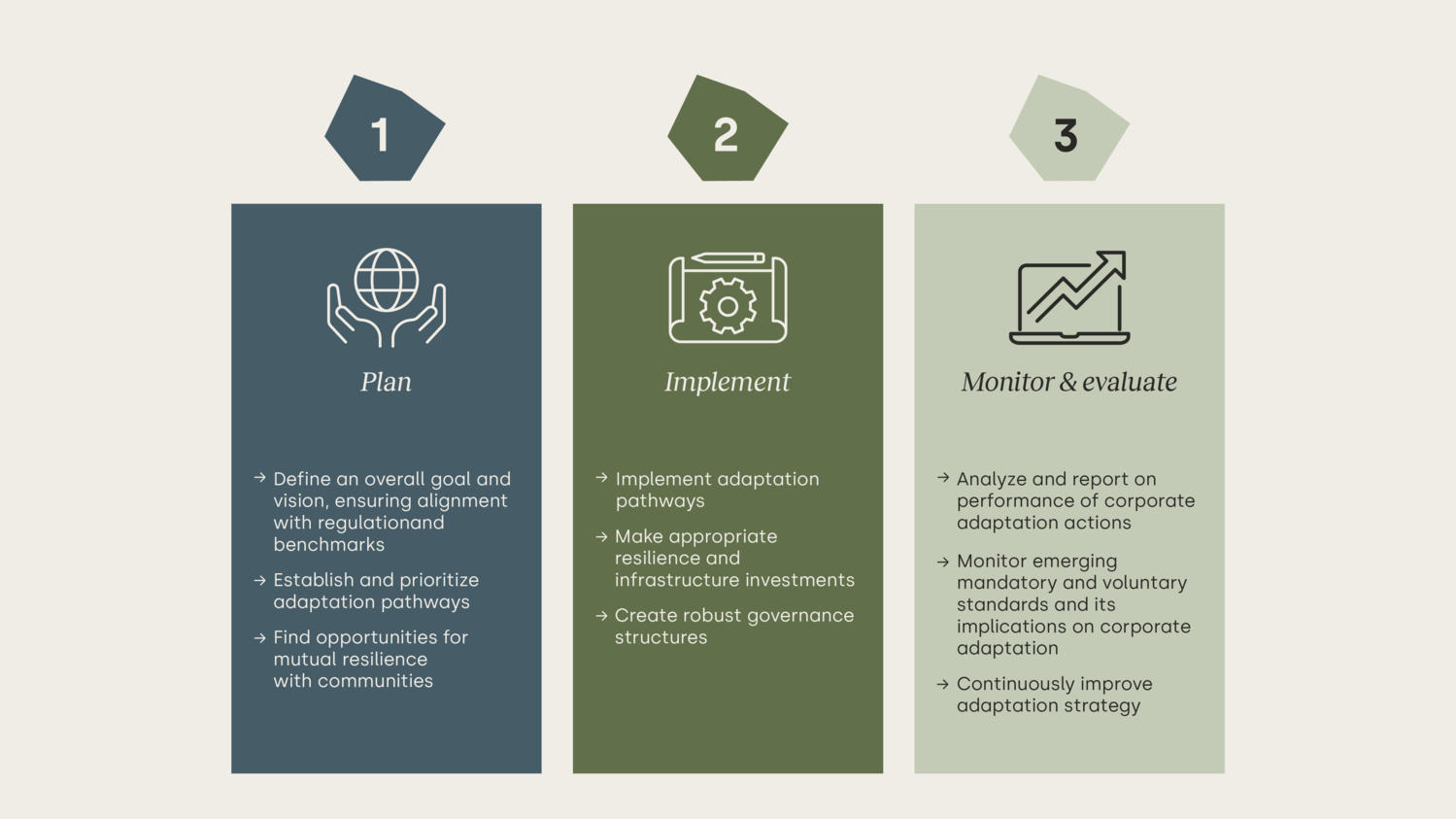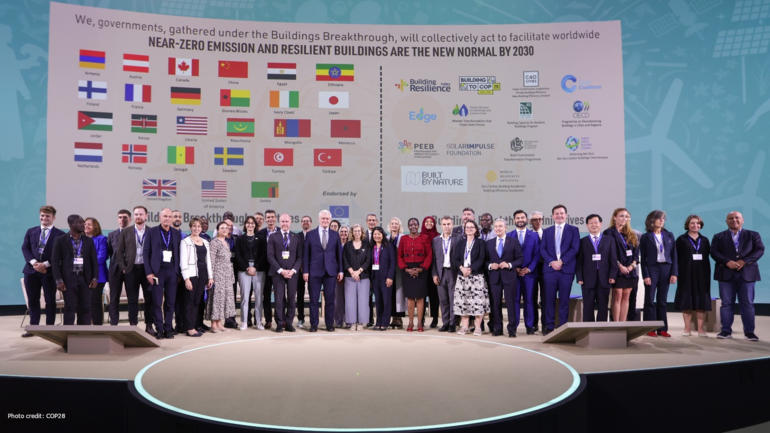In the face of escalating climate risks that affect companies and communities worldwide, the World Business Council for Sustainable Development (WBCSD) recognizes the pressing need to foster innovative thinking and long-term strategic decision-making to build resilience. In this Insights article, we introduce the "Three Horizons" framework, a tool designed to guide organizations in transitioning from short-term to long-term decision-making. This shift empowers companies to create strategies and take actions to not only minimize risks but also unlock opportunities for long-term value creation.
Why does business need to increase resilience to climate change?
Climate change is disrupting business across value chains, degrading ecosystems, and increasingly impacting the most vulnerable populations around the world.
According to CDP analysis of 500 of the world’s biggest companies by market capitalization (G500), 215 companies estimated financial impacts of around $350-400 billion in physical climate risks in the coming decades. A different study from the Economics of Climate Adaptation estimates that 40-70% of losses expected by 2030 could be avoided through cost-effective adaptation and resilience solutions. Furthermore, the Global Center on Adaptation found that investing $1.8 trillion globally in five areas from 2020 to 2030 could generate $7.1 trillion in total net benefits.
Existing commitments and actions put us at risk of breaching 1.5 degrees Celsius of warming, and most companies remain unprepared for the impending climate impacts. To ensure resilient, long-term value creation that minimizes risks and maximizes opportunities, companies must develop strategies to:
- Eliminate 90-95% of value chain emissions by 2050 (and 50% by 2030) and neutralize the remaining 5-10% emissions with permanent carbon removals
- Adapt and build resilience to the increasing climate impacts of extreme weather events and changing weather patterns
Why is it currently challenging for business to make decisions to increase resilience to climate change?
There is a low sense of urgency among many businesses and key decision-makers to act on adaptation in parallel with mitigation. Many businesses find it difficult to prioritize adaptation due to the uncertainty of climate risks and lack of understanding on the return on investment of adaptation efforts. Therefore, as a WBCSD member company states: “It's challenging to make business decisions based on the levels of uncertainty that you might be seeing 30 years from now, or 50 years from now”.
What approach can companies use to make climate-resilient decisions?
To effectively minimize risks, benefit from opportunities, and increase overall resilience to climate change, businesses need to implement methods to enable decisions under increased uncertainty. This entails using approaches that extend the typical 2-to-3-year decision-making horizon to 10, 20, 50 years into the future.
Companies may use a range of methods, called Foresight and Futures Practices, to go beyond conventional plans and forecasts to enable leaders to work with agency in the face of future uncertainties. These practices go beyond forecasting to prepare companies for multiple possible futures, so companies can build internal adaptive capacity to manage emergent and unexpected conditions. For example, the Task Force on Climate-Related Financial Disclosures (TCFD) recommends that companies use the foresight approach of scenario analysis to assess risks and build resilience to climate change.
Besides integrating scenario analysis into decision-making, companies should use a pathways approach to make climate-resilient decisions in the short, medium, and long term. A pathways approach enables flexible navigation towards a visionary goal, allowing for adaptive and transformative action to manage the increasing uncertainty and localized complexities of climate change. Furthermore, adaptation pathways enable companies to decide the right adaptation measure and investment at the right time along the climate resilience journey.
How can companies implement a pathways approach to make climate-resilient decisions?
One framework companies can use to implement a pathways approach is Three Horizons (3H). This framework supports strategic conversations within and between organizations to move beyond incremental change to the systemic change that supports long-term value creation. It supports companies to identify choices between innovation that sustains our current system to the transformative innovation needed to build climate resilience. As described further in the video below, this simple framework helps businesses to work out: 1) where we are, 2) where we want to be, and 3) how to get there.
How should companies develop their own adaptation pathway approaches?
Companies should aim to develop adaptation pathways that are flexible, minimize risks, and maximize opportunities associated with changes in physical climate. To achieve this, companies should plan, implement, and monitor their adaptation strategies according to the recommendations in the figure below:
To capture the greatest return on investment and competitive advantage of building resilience, companies need to integrate these transformative pathway approaches as early as possible. These forward-thinking and strategic approaches will ultimately enable early movers to effectively innovate and develop climate-resilient products and services that increase profitability while maximizing value creation for business, society, and nature.
Where can you get further support on this topic?
WBCSD
Download the report ‘Strategic Resilience: A Primer for Business' for further information on foresight capacity and business resilience. Furthermore, WBCSD’s Adaptation & Resilience workstream (through the Climate and Agriculture & Food programs) will continue to support its member companies to navigate challenges related to building resilience and will develop business-focused how-to guidance on adaptation planning and pathways. In 2024, WBCSD will be releasing guidance to support senior business leaders to build resilience by adapting their organizations to manage physical risk and unlock new opportunities. For more information on how to get involved in the WBCSD's Adaptation and Resilience workstream, please contact Madeline Ojakovoh at ojakovoh@wbcsd.org.
Future Stewards
Supporting resources, videos, and links to organizations using Three Horizons can be found at www.futurestewards.com.
Leaders’ Quest
Leaders’ Quest (LQ) grows wise leaders for a regenerative future. LQ’s alchemy is in bringing different worlds together to partner on meaningful change. As a social enterprise, LQ has spent over 20 years developing wise leaders who are building a more equitable, inclusive and sustainable world. The work ranges from helping CEOs to align profit with purpose to facilitating cross-sector collaboration towards solutions to the defining challenges of the 21st century. For support in Three Horizons workshop facilitation, please contact Carolina Moeller, Partner at Leaders’ Quest at Carolina.Moeller@leadersquest.org, or Rosa Sommer, Director at Leaders’ Quest at rosa.sommer@leadersquest.org.









